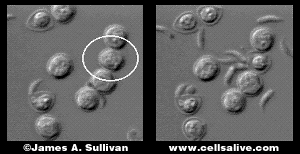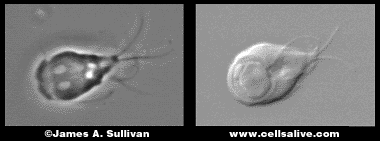It used to be that when you took a hike in the woods you could stick your face in the flow of any stream and drink to your hearts content. Those days are gone. Today microscopic single-celled parasites known as Giardia and Cryptosporidia infect streams, lakes, and wells throughout the United States and inflict diarrhea on hundreds of thousands of people each year. Giardia is the best known of these culprits, which are actually organisms known as protozoa, but Cryptosporidia is widespread as well. Both cause horrible diarrhea, with dehydration, and sometimes intense stomach pain. Even death may result in people with immune systems weakened by HIV, chemotherapy treatments, or organ transplants. In the presence of chlorine or iodine, or when placed out of water, these parasites develop hard shells and turn into resistant cysts that are very hard to kill. The wall of a cyst is circled in the photo below. Once the cyst is inside a host, stomach acids weaken the shells, which are discarded after the parasites make their way into the intestines. Freed from their shells and mobile, the parasites burrow into or attach to the walls of the intestines, causing cramps and diarrhea as the body tries to dislodge them. Because many cities are unable completely remove Giardia and Cryptosporidia cysts from their water supplies, even drinking water direct from the faucet may be infected. In fact, cysts have been found in most major municipal water supplies in the United States, and more than 63% of water problems in the United States may be caused by Giardia and Cryptosporidia. Milwaukee had a huge Cryptosporidia outbreak in 1993 that infected half a million people and resulted in 100 deaths. Also, San Francisco has repeatedly found Giardia cysts in chlorinated drinking water that has traveled hundreds of miles from Sierra Nevada reservoirs.
Giardia infection is almost always the result of drinking unfiltered water, or inadvertently swallowing contaminated water when swimming. However, a few outbreaks have resulted from eating raw vegetables that were contaminated by infected or infested food handlers. Cool moist conditions favor survival of the parasite when it is out of water. Cryptosporidia infections may also result from drinking unpasturized cider or milk. It is particularly common at daycare centers, especially where diapering is done, and is widespread at dairy farms, being a common cause of diarrhea in calves. Before blaming drinking water as the source of an infection, swimming, unpasturized cider and dairy products, and exposure to diapers, daycare facilities, pets, livestock, and other people must be considered as well. No drugs are universally effective in treating infections from either parasite. Some drugs work on some people, but not on others. Water lost by diarrhea is the most serious effect of infection and drinking fluids to replenish lost water is the obvious treatment.
Prevention is much more effective than treatment. DRINK ONLY FILTERED WATER in the outdoors and avoid swallowing water when swimming in lakes, ponds, and rivers. Washing your hands, especially after exposure to diapers and livestock, appears to be most effective in preventing the spread of Cryptosporidia. Additionally, you should thoroughly wash all vegetables, and avoid drinking unpasturized milk and cider.
Cryptosporidia is a spherical, single-celled protozoa found in contaminated water and foods, and widespread in dairies and daycare centers. It occurs as spherical cysts about 4 to 6 microns in diameter. According to the Food and Drug Administration (FDA), ingesting 137 cysts infects 50% of the people exposed, and ingesting 300 cysts infects 66%.
Healthy victims usually recover without treatment, and some victims may not develop symptoms at all during infection. However, cryptosporidiosis can, in rare cases, be fatal to those with weak immune systems, including infants, the elderly, those who are HIV positive, and chemotherapy and organ replacement patients. An estimated 20% of all AIDS patients have cryptosporidiosis at some time during their battle with that disease.
Giardia lamblia is a single-celled, flagellated parasite (protozoa) found in contaminated water and food as ovoid cysts measuring about 6 by 10 microns. It is also known in Europe as Lamblia intestinalis and it is the most common cause of non-bacterial diarrhea in North America. Giardia lives part of its life cycle in domestic animals (dogs and cats), wild animals (particularly bears and beaver), or humans. Unwary hikers and swimmers are usually infected by inadvertently drinking water contaminated by the feces of infected animals or people, but infection sometimes results from eating raw vegetables contaminated by infected or infested food handlers.
The incubation period for giardiasis, the name for diarrhea resulting from Giardia infection, is typically one week, but incubation can be longer in some people. Generally, diarrhea and amazingly foul gas begin a few days after drinking infected water and last for a couple of days. However, the nature and severity of symptoms vary, depending on the person. A few days later the diarrhea returns, and after two or three cycles of normalcy and illness the severity of diarrhea lessens. After 2 to 3 weeks the diarrhea ends for most, but for some unfortunate souls months, even years, are required for the parasite to be completely flushed from the body. A single Giardia cyst can cause infection, and studies show 100% infection with exposure to only 10 cysts. By contrast, most bacterial illnesses require hundreds to thousands of organisms to produce illness. Giardia causes as much as 25% of all diarrhea cases in North America, making it the most common non-bacterial cause of diarrhea. |

 Giardia cysts survive 1 to 3 months in water and are highly resistant to chlorine. Once inside a human or animal "host", the shell of the cyst is discarded, allowing the parasite to develop a tail of five flagella and become mobile. The flagella can be seen in the photos on the left. The two "eyes" visible on the body in the left-hand photo are actually a pair of nuclei. Giardia uses a ventral suction cup, visible in the right-hand photo, to attach to the walls of the host intestine (epithelium), and there is some evidence that a heavy infection of attached Giardia blocks the transport of nutrients across the epithelium. Also, there is some evidence that Giardia may produce a toxin.
Giardia cysts survive 1 to 3 months in water and are highly resistant to chlorine. Once inside a human or animal "host", the shell of the cyst is discarded, allowing the parasite to develop a tail of five flagella and become mobile. The flagella can be seen in the photos on the left. The two "eyes" visible on the body in the left-hand photo are actually a pair of nuclei. Giardia uses a ventral suction cup, visible in the right-hand photo, to attach to the walls of the host intestine (epithelium), and there is some evidence that a heavy infection of attached Giardia blocks the transport of nutrients across the epithelium. Also, there is some evidence that Giardia may produce a toxin.